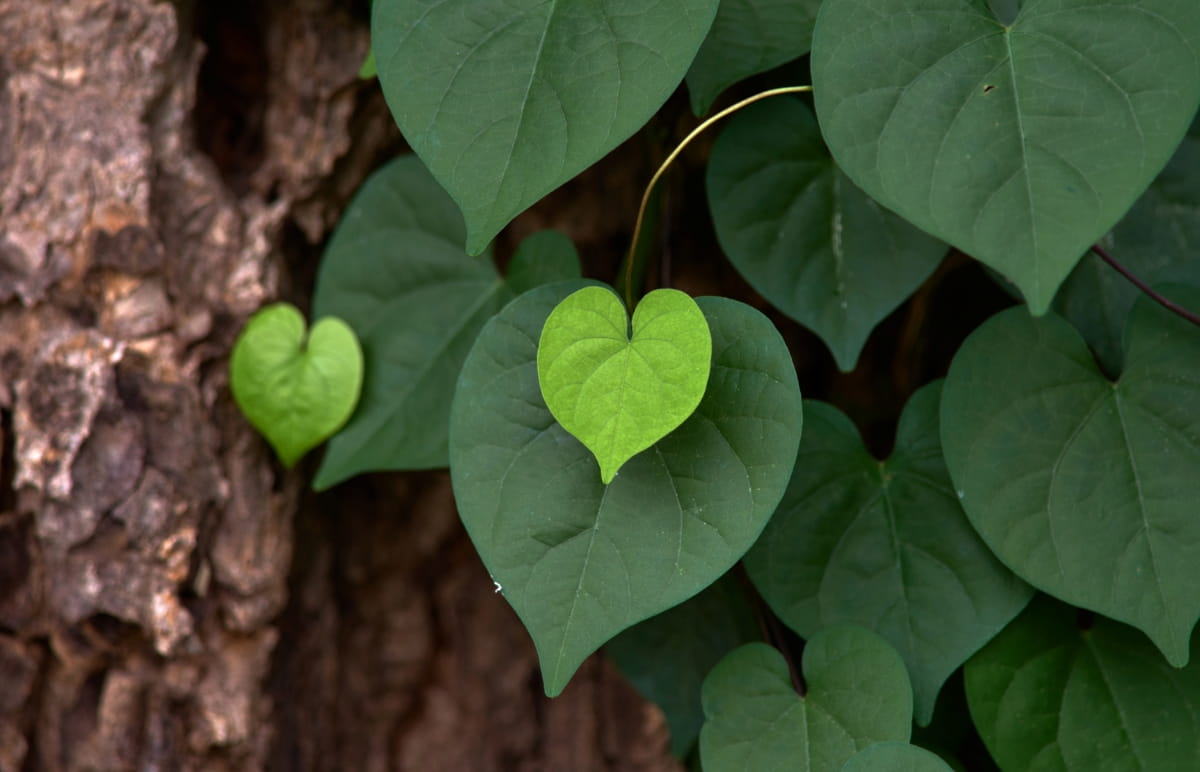Heart-shaped leaves trees add a unique touch to any garden or landscape with their distinct foliage that looks like the shape of a heart. These trees not only look stunning, but they also have special significance as symbols of love and affection.

Top 10 Trees with Heart-Shaped Leaves
Silver Linden
It is a deciduous tree with heart-shaped leaves. It can grow 70 feet tall, making it an excellent addition to any backyard or garden. This beautiful tree requires moderate watering and prefers well-drained soil. It also benefits from regular pruning to remove any dead or damaged branches. In terms of care, Silver Linden is relatively low maintenance compared to some other trees with heart-shaped leaves. However, it may be susceptible to pests such as aphids and spider mites during the hot summer.
In case you missed it: How to Plant and Care for Cardinal Flowers: Growing Instructions for Beginners

Henry’s Lime
Henry’s Lime can reach up to 20 meters in height and has a dense crown. One of Henry’s Lime’s unique features is its fragrant flowers that bloom during summer and attract bees, making it perfect for honey production. The pale-yellow flowers grow in clusters at the end of branches and are followed by small round fruits.
The bark of this tree is grayish-brown and has shallow ridges that run vertically along the trunk. It is also worth noting that this tree blooms in late June with small yellow flowers that hang from long, slender stems. Henry’s Lime prefers full sun exposure but grows well under partial shade. It requires fertile soil with good drainage ability for optimal growth and development.
Yellow Catalpa
Yellow catalpa, also known as Catalpa ovata, is a deciduous tree native to China. Its heart-shaped leaves are bright green and turn yellowish-green in the fall. The yellow catalpa stands out from other trees with its showy white flowers that bloom during springtime. This tree prefers moist soils and can tolerate full sun or partial shade. It can grow 50 feet tall, and it’s commonly used as an ornamental landscape tree due to its unique shape and vibrant foliage colors.
Northern Catalpa
Northern Catalpa is a stunning tree that boasts large, heart-shaped leaves. Native to the central and eastern United States, this deciduous tree can grow up to 70 feet tall with a spread of 50 feet. The tree’s fragrant flowers attract pollinators such as bees and butterflies, making it an asset in gardens. The Northern Catalpa produces large clusters of showy white flowers with purple and yellow markings. These blooms have a sweet fragrance that attracts bees, butterflies, and hummingbirds. The flowering season occurs between May and June.
This tree’s growth rate varies from slow to moderate depending on soil conditions and water availability. However, it does require plenty of sunlight to thrive properly. If you plan on planting one in your yard, ensure no obstructions are blocking its sun exposure. The Northern Catalpa is an excellent addition to any garden or landscape where space allows for a mature tree’s size. Its unique features will provide visual interest throughout all seasons while remaining low-maintenance once established properly.
Western Redbud
The Western Redbud tree is a stunning addition to any garden or landscape. Known for its heart-shaped leaves, this flowering tree produces vivid pink flowers in early spring that will catch anyone’s eye. The Western Redbud is a drought-tolerant plant that prefers well-drained soil and full sun exposure.
It can grow 20 feet tall and wide, making it an ideal choice for small yards or gardens. One of the best things about the Western Redbud is its versatility – it can be trained into a single-trunked tree or pruned into a multi-stemmed shrub. This makes it perfect for both formal and informal landscapes.
Quaking Aspen Tree
Quaking Aspen is a beautiful tree with heart-shaped leaves in many parts of North America. The bark of this tree is smooth and white to grayish-green, providing an excellent contrast to its green foliage. It turns into brilliant yellow or golden color in autumn, making it a stunning display against blue skies.
Quaking Aspens prefer moist soil conditions but are adaptable to various soil types as long as they receive adequate sunlight. Like most trees, they also have shallow roots stretching horizontally rather than deep into the ground.
Eastern Redbud
It is a beautiful ornamental tree with heart-shaped leaves. It is native to North America and can be found in many gardens and parks worldwide. The Eastern Redbud produces pink or purple flowers that bloom before the leaves appear. The blooms attract pollinators such as bees, butterflies, and hummingbirds. This deciduous tree grows up to 30 feet tall with a spread of about 25 feet wide. It prefers well-drained soils and partial shade but can also tolerate full sun.
Foxglove Tree
It is a beautiful deciduous tree found in many parts of the world. This tree features heart-shaped leaves, making it an ideal addition to any garden or landscape. One of the most striking things about the Foxglove Tree is its large, bell-shaped flowers that bloom in early spring. These flowers come in shades of lavender and pink and add a pop of color to any outdoor space.
Aside from its stunning appearance, this tree has practical uses, such as timber production, furniture making, and even medicinal purposes. The bark and leaves of the Foxglove Tree have been traditionally used in Chinese medicine for their anti-inflammatory properties.
American Lime
It is a deciduous tree that belongs to the Tiliaceae family. The American Lime stands out for its beautiful heart-shaped leaves, making it a popular landscaping choice. The plant leaves are dark green on top and lighter underneath, providing a stunning contrast against blue skies or white snow. Apart from being aesthetically pleasing, American Limes are also highly valued for their medicinal properties. For centuries, Native Americans have used different parts of the tree to treat various ailments such as headaches, fever, coughs, and colds.
Empress Tree
It is well-known for its stunning heart-shaped leaves and beautiful violet flowers that bloom in early spring. This magnificent tree can grow up to 70 feet tall with an average lifespan of 50 years. Its leaves can reach up to 12 inches long and wide, making it one of the largest trees with this leaf shape. One of the benefits of planting an Empress Tree is its ability to thrive in various soil types and climates. It can withstand drought conditions but prefers moist soil with good drainage.
In case you missed it: How to Plant and Care for Chrysanthemums: Outdoor Growing Instructions

This tree also has low water requirements, which makes it perfect for areas with limited rainfall. Another perk of this tree is that it produces stunning purple flowers in the springtime before its leaves emerge. These blooms attract pollinators such as bees and butterflies, making them valuable to any garden or wildlife area. To care for your Empress Tree, prune away damaged or dead branches during late winter or early spring before new growth appears. Also, apply organic mulch around the tree’s base annually to help retain moisture in the roots.
Conclusion
Heart-shaped leaves are a fantastic addition to any landscape design due to their striking appearance, ease of care, and adaptability. Caring for trees with heart-shaped leaves is essential to ensure they grow healthy and strong. The unique shape of the leaves adds visual interest and can create a romantic and charming atmosphere.
- Feed Your Flock for Less: Top 10 Tips to Save on Chicken Feed
- Ultimate Guide to Ossabaw Island Hog: Breeding, Raising, Diet, and Care
- Hatching Answers: The Top 10 Reasons Your Chickens Aren’t Laying Eggs
- Eggs and Economics: Breaking Down the Cost of Raising Backyard Chickens
- Defend Your Greens: Proven Methods to Keep Iguanas Out of Your Garden
- Ultimate Guide to Cinnamon Queen Chicken: A Comprehensive Guide for Beginners
- Ultimate Guide to California Tan Chicken: Breeding, Raising, Diet, Egg-Production and Care
- Ultimate Guide to Marsh Daisy Chicken: Breeding, Raising, Diet, and Care
- 10 Types of Chicken Farming Businesses You Can Start for Profits